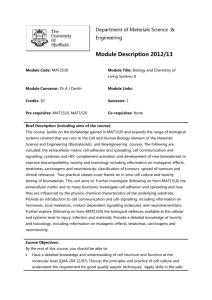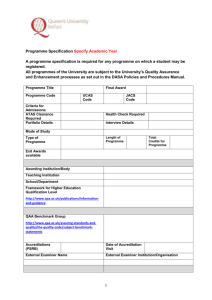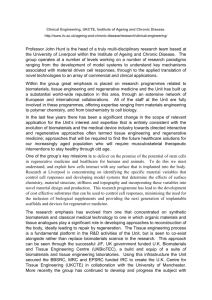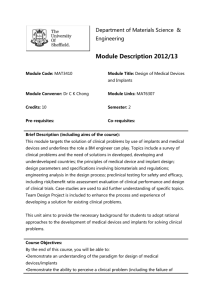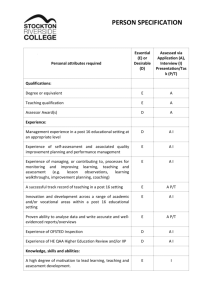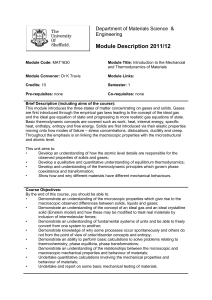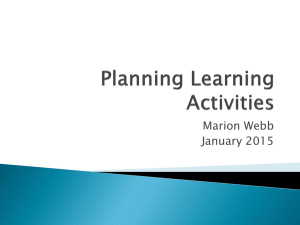Module Description 2012/13
advertisement
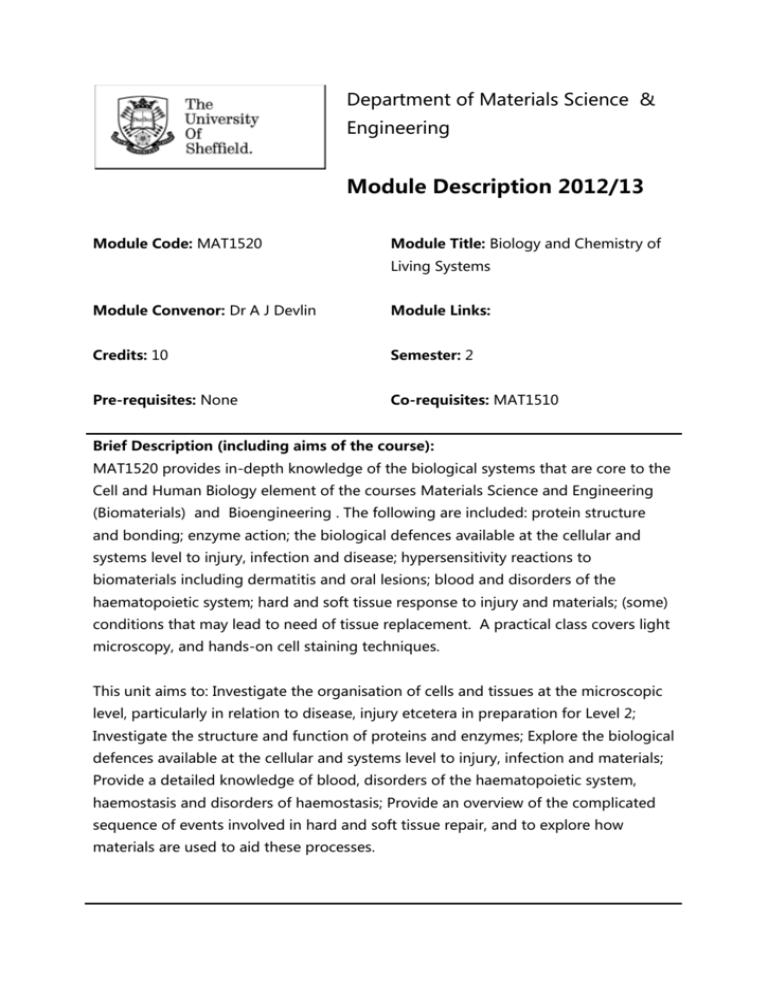
Department of Materials Science & Engineering Module Description 2012/13 Module Code: MAT1520 Module Title: Biology and Chemistry of Living Systems Module Convenor: Dr A J Devlin Module Links: Credits: 10 Semester: 2 Pre-requisites: None Co-requisites: MAT1510 Brief Description (including aims of the course): MAT1520 provides in-depth knowledge of the biological systems that are core to the Cell and Human Biology element of the courses Materials Science and Engineering (Biomaterials) and Bioengineering . The following are included: protein structure and bonding; enzyme action; the biological defences available at the cellular and systems level to injury, infection and disease; hypersensitivity reactions to biomaterials including dermatitis and oral lesions; blood and disorders of the haematopoietic system; hard and soft tissue response to injury and materials; (some) conditions that may lead to need of tissue replacement. A practical class covers light microscopy, and hands-on cell staining techniques. This unit aims to: Investigate the organisation of cells and tissues at the microscopic level, particularly in relation to disease, injury etcetera in preparation for Level 2; Investigate the structure and function of proteins and enzymes; Explore the biological defences available at the cellular and systems level to injury, infection and materials; Provide a detailed knowledge of blood, disorders of the haematopoietic system, haemostasis and disorders of haemostasis; Provide an overview of the complicated sequence of events involved in hard and soft tissue repair, and to explore how materials are used to aid these processes. Course Objectives: By the end of this course, you will be able to: Discuss the microscopic appearance of cells and tissues and relate these to underlying disease processes (QAA 204 12/07); Relate the structure and function of nucleic acids, proteins and enzymes to the chemical properties of their building materials (QAA 204 12/07); Demonstrate an appreciable knowledge of the immune system including immunoglobulins, autoimmunity and hypersensitivity reactions; Have a detailed knowledge of innate and acquired immunity and of the regulation of immune responses, and be able to discuss specific examples (QAA 204 12/07); Have a knowledge and understanding of diseases of haematopoiesis and haemostasis, and of the anaemias and leukaemias (QAA 204 12/07); Demonstrate an appreciation of both hard and soft tissue responses to injury and their ability for self repair and aided (by biomaterials) repair; Demonstrate an appreciable knowledge of materials selection, including material and processing methods (QAA 245 04/08); Demonstrate an appreciable knowledge of appropriate biomaterials (QAA 245 04/08). Assessment: Exam: 75% Practicals: 10% Other: 15% (Poster) Booklist (A) Core Test; (B) Secondary Text; (C) Peripheral Reading: (A) E N Marieb. Human Anatomy and Physiology (6th edition), (Addison Wesley Longman). ISBN 0-8053-4989-8 (B) B Alberts, D Bray, A Johnson, J Lewis, M Raff, K Roberts, P Walker. Essential Cell Biology: An Introduction to the Molecular Biology of the Cell, (Garland). ISBN 08153-2791-7 (B) B D Ratner, F J Schoen, J E Lemons. Biomaterials Science: An Introduction to Materials in Medicine, (Academic Press). ISBN 0-12-582460-2 UK-SPEC Learning Outcomes Please insert an 'x' in the table below against all learning outcomes that are delivered in the module. N.B. The suffix 'm' indicates learning outcomes that are characteristic of the enhanced outcomes expected of MENG graduates. LEARNING OUTCOME DESCRIPTION US1 Knowledge & understanding of scientific BENG MENG principles & methodology necessary to underpin their education in their engineering discipline, to enable appreciation of its scientific and engineering context, & to support their understanding of the historical, current & future developments and technologies Underpinning Science & Mathematics US1m x x x x x x x x A comprehensive understanding of the scientific principles of own specialisation & related disciplines US2 Knowledge & understanding of mathematical principles necessary to underpin their education in their engineering discipline and to enable them to apply mathematical methods, tools & notations proficiently in the analysis & solution of engineering problems US2m An awareness of developing technologies related to own specialisation US3 Ability to apply & integrate knowledge & understanding of other engineering disciplines to support study of their own engineering discipline US3m A comprehensive knowledge & understanding of mathematical & computer models relevant to the engineering discipline, and an appreciation of their limitations US4m An understanding of concepts from a range of areas including some outside engineering, and the ability to apply them effectively in engineering projects E1 x x x x Understanding of engineering principles and the ability to apply them to analyse key engineering processes E1m An ability to use fundamental knowledge to investigate new & emerging technologies E2 Ability to identify, classify and describe the performance of systems & components Engineering Analysis through the use of analytical methods & modelling techniques E2m Ability to apply mathematical & computerbased models for solving problems in engineering, & the ability to assess the limitations of particular cases E3 Ability to apply quantitative methods & computer software relevant to their engineering discipline, in order to solve engineering problems E3m Ability to extract data pertinent to an unfamiliar problem, & apply in its solution using computer-based engineering tools when appropriate E4 Understanding of & ability to apply a systems approach to engineering problems D1 Investigate & define a problem & identify constraints including environmental & Design sustainability limitations, health & safety & risk assessment issues D1m Wide knowledge & comprehensive understanding of design processes & methodologies & the ability to apply & adapt them in unfamiliar situations D2 Understand customer & user needs & the importance of considerations such as aesthetics D2m Ability to generate an innovative design for products, systems, components or processes to fulfil new needs D3 Identify & manage cost drivers D4 Use creativity to establish innovative solution D5 Ensure fitness for purpose for all aspects of the problem including production, operation, maintenance & disposal D6 Manage the design process & evaluate outcomes S1 Knowledge & understanding of commercial & economic context of engineering processes S1m Extensive knowledge & understanding of Economic, Social & Environmental Context management & business practices, & their limitations, & how these may be applied appropriately S2 Knowledge of management techniques, which may be used to achieve engineering objectives within that context S2m The ability to make general evaluations of commercial risks through some understanding of the basis of such risks S3 Understanding of the requirement for engineering activities to promote sustainable development S4 Awareness of the framework of relevant legal requirements governing engineering activities, including personnel, health, safety, & risk (including environmental risk) issues S5 x x x x Understanding of the need for a high level of professional & ethical conduct in engineering P1 Knowledge of characteristics of particular materials, equipment, processes, or products x x appreciation of likely new developments x x P2 Workshop & laboratory skills x x P2m Extensive knowledge & understanding of a x x x x P1m A thorough understanding of current practice & its limitations, & some Engineering Practice wide range of engineering materials & components P3 Understanding of contexts in which engineering knowledge can be applied (e.g. operations & management, technology development, etc) P3m Ability to apply engineering techniques taking account of a range of commercial & industrial constraints P4 Understanding use of technical literature & other information sources P5 Awareness of nature of intellectual property & contractual issues P6 Understanding of appropriate codes of practice & industry standards P7 Awareness of quality issues P8 Ability to work with technical uncertainty
